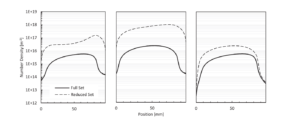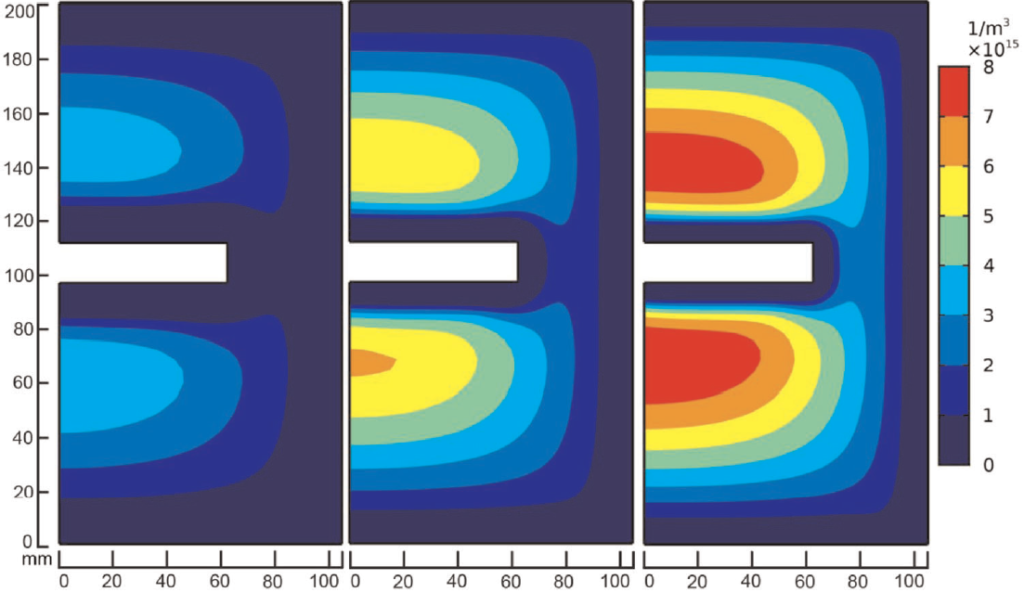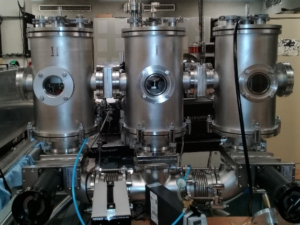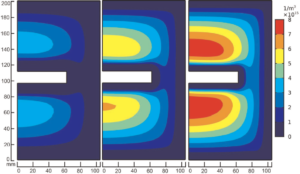A key finding from our work was that the inclusion of resonant and higher 2p states of argon can have a significant effect on the spatial distribution and population of singly ionised argon (Ar+), metastable argon (Arm) and electrons. This could have significant implications for plasma-based surface engineering processes, including thin film deposition, and etching.
Functionalised plasma polymerised nanoparticles (PPNs) are a promising platform for targeted drug delivery to diseased tissues and for use as target specific probes in diagnostic applications. Synthesis of PPNs can be carried out using a low pressure, capacitively coupled plasma discharge, which avoids the process complexity and hazardous chemicals associated with conventional ‘wet chemistry’ synthesis techniques. PPNs can be synthesised from a three-component plasma comprising argon, nitrogen, and acetylene, under specific pressures and applied power. The nanoparticles grow dynamically in the plasma chamber and are subjected to a range of forces, which makes this a difficult system to study.
To develop a commercially feasible production process for PPNs, it is essential to achieve tight control of particle size, composition, density, and surface properties, whilst avoiding losses to the pumping system. Conventionally this has been achieved through lengthy and expensive trial-and-error in the laboratory (our test chamber is shown in Figure 1). We sought to build a model of the plasma discharge that would allow us to understand the fundamental dynamics of the system and optimise the process by mapping the parameter space and assessing the effect of different inputs.


COMSOL Multiphysics and the Plasma Module are the best option available for simulating nonthermal plasmas. The graphical user interface is highly intuitive, making it accessible to users of various skill levels. There is a large degree of control over the meshing, the in-built solvers can robustly handle difficult models, and a wide range of physics and boundary conditions accommodate many different system configurations. The COMSOL support team is very helpful and has provided invaluable assistance throughout our entire model development experience.
Our CCRF chamber features wide electrode spacing to accommodate large samples (Figure 2). A strong DC self-bias is observed to form on the powered electrode during operation, which would be difficult to model were it not conveniently included as a feature in the COMSOL Plasma Module. The availability of a time-periodic study offered a significantly faster solution method compared to a fully transient approach. The Plasma Module worked seamlessly with the public database LXCat for plasma reference data that is widely used in the field.
Using COMSOL we were able to simulate a CCRF argon discharge in our chamber with a 2D axisymmetric plasma fluid model. Our simulations showed the development of two distinct discharge regions with asymmetric power deposition. The results compared very favorably with reported experimental values in the literature, highlighting the potential accuracy that can be achieved with the COMSOL Plasma Module. The electron density distributions for 25 W applied power at 0.1 Torr, 0.2 Torr, and 0.3 Torr pressures are shown in Figure 3, highlighting the dual discharge zones above and below the powered electrode. The model provided a wealth of information regarding key plasma parameters, and how they varied with different inputs.


A model of a nonthermal argon CCRF discharge was built using the COMSOL Plasma Module and used to understand the forces acting on charged nanoparticles in a complex plasma. The modular nature of the COMSOL Multiphysics platform allows us to parameterise the process conditions and chamber design to optimise our nanoparticle production process and build in more model complexity as required. The results from this project were published in the journal Plasma Processes and Polymers (https://onlinelibrary.wiley.com/doi/abs/10.1002/ppap.202000243) and have also resulted in the filing of a patent for a novel high yield nanoparticle production process.